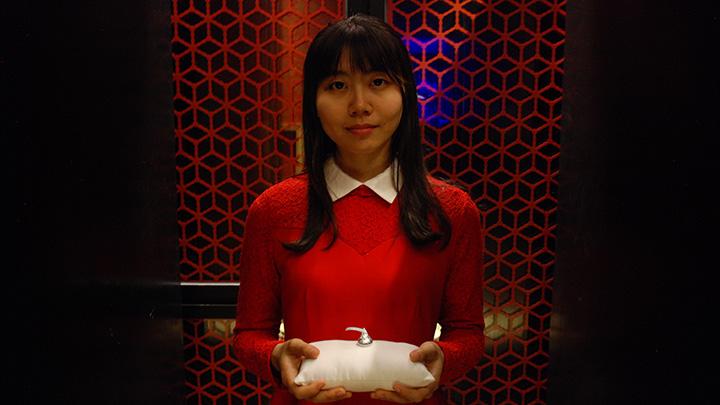Night Magic
Performing for a single audience member at a time — in Taiwan
It is 1 a.m. at The Place Hotel in Tainan, Taiwan. You are here to see a performance, but there is no theater, no stage. Just you, in a silent hotel lobby, at night. As the performance begins, one of the performers of Night Magic greets you in the lobby, leading you to an elevator. You get in, and the elevator goes up. The door opens, exposing a wall, blocking your view of what lies beyond. Through a small opening in the wall, a woman hands you a glass of wine.
For half an hour, you are led through various hotel rooms and corridors — spaces made eerie by night and a series of dreamlike scenes. You are an audience of one in a building that has transformed into a surreal set. The performers outnumber you ten to one, and all of their attention is focused on you.
A Unique Summer MAP
In June 2017, Grinnell students Amaris Bates ’18, Nolan Boggess ’19, Dru Greenwood ’18, and Yi-Chia Wang ’20 traveled to Taiwan with Craig Quintero, associate professor of theatre, to carry out a Mentored Advanced Project (MAP). The mission of this MAP: team up with six Taiwanese actors to put on Night Magic, a play exploring how night alters human senses.
Collaborating Across Cultures
After a thirteen-hour flight to Taipei and train journey to Tainan, the students hit the ground running with two weeks of rehearsal. They became temporarily nocturnal in preparation for their nighttime performances, and familiarized themselves with The Place Hotel — their stage and their home for the month.
Far from being a time spent memorizing lines, the two-week rehearsal period was immersive, collaborative, and exploratory. Grinnell students and Taiwanese actors quickly established friendship and trust across language barriers through improvisational exercises. Because Quintero is a highly visual director and likes to adapt his concepts to the spaces they inhabit, there was room for the actors to add their own personal touch. “A lot of ideas from cast members got used in the final show,” says Boggess. “It felt like we all contributed to the piece.”
Performing for an Audience of One
After two weeks of rehearsal, the students and local actors put on 60 half-hour performances between 1:00 a.m. and 5:15 a.m. for one person each. Acting for just one person at a time proved to be one of the most challenging and personally fulfilling aspects of the project for the students.
“Although I had prior acting experience in plays and musicals, this performance was going to be something completely different than I was used to,” says Boggess. “The idea of performing in the middle of the night with a one-member audience seemed so interesting and intimate.”
The actors had to adjust their movements every performance to meet the needs of the individual audience members, while remaining entirely authentic. “In some ways, it was scary to be a performer in front of one person because they can instantly see whether or not you're phoning in a certain emotion,” says Boggess.
Sometimes, the audience member was instantly sucked in. Others took more time to let their guard down. The audience couldn’t rely on cues from others to gauge how they should be feeling, requiring more engagement and introspection than when attending a more traditional performance.
Engaging Authentically
Quintero has staged many site-specific performances for an audience of one with his Taiwan-based Riverbed Theatre Company. He enjoys giving students the chance to act in these productions because it challenges them to think about their acting, and the audience, in a new and more personal light.
“Performing in such an intimate setting has changed the way I think about performance in general,” says Bates. “We all worked on performing with total honesty.”
This honesty is exactly what Quintero is looking for in his productions. When students carry out such intimate performances in close collaboration with actors from a different culture, it requires openness, authenticity, and adaptability from all involved. “Once we start to embrace the music of chance,” he says, “it changes how we experience the world.”
What’s Next
Quintero will co-direct his next production for an audience of one with Andrew Kaufman, associate professor of art, at the Taipei Museum of Contemporary Art in March. They will bring eight Grinnell students to work on the installation and performance.




